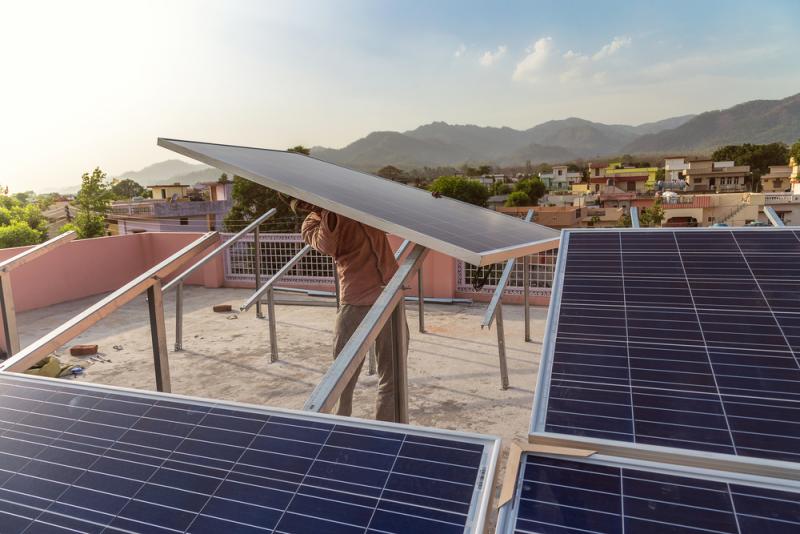Last week, Tata Power and The Rockefeller Foundation announced the launch of TP Renewable Microgrid Ltd to install 10,000 microgrids in India by 2026 and become the world’s largest microgrid developer and operator. The plan includes reliable access to clean energy for almost 50 lakh homes, which would avoid about 1 million tonnes of CO2 emissions through the deployment of small distributive grids of under-10KW capacities running on renewable sources.
While India has not seen ambition of this scale before, the idea of microgrids is not a new one. Since the 1990s, examples of microgrids have sprouted around energy-scarce regions of the country where centralised grid connections are still a relatively recent phenomenon. The efforts of successive governments over the last three decades has seen near-100% electrification in the country, yet somewhat surprisingly, the launch of TP Renewable Microgrid Ltd is evidence that microgrids are still relevant in the country.
India’s electrification story has been riddled with unreliability in terms of access and quality of power at the consumers’ end, especially in rural India. Microgrids, which can operate both as stand-alone distributive networks for a small area or integrated with a main grid, have long been offered as a silver bullet to solve this “last mile” glitch and in remote areas where achieving and maintaining central grid connectivity can be challenging. Not only would these solve energy scarcity, it would also enable feeding back of surplus energy generated into the main grid. In fact, micro- and mini-grids have proven to be economically beneficial and have received positive reactions across villages in Uttar Pradesh, Jharkhand, Chhattisgarh and Karnataka, which host microgrids through NGOs, private and public interventions. But despite clear positive feedback, little has happened in terms of scaling up coverage. Despite a target of 500 MW renewable microgrid capacity announced in 2016, a minute fraction of that had been achieved by 2018.
“Discoms are not merely inefficient, but they create the biggest hurdle for the creation of microgrids, so our job is to not merely bypass the discoms, but to ensure that these discoms become catalysts for growth for microgrids…Left to discoms, nothing will happen. They need to go bust for microgrids to take off,” exhorted Aimtabh Kant, CEO of NITI Aayog, placing the blame squarely on state discoms. Discoms are undoubtedly a part of the problem. Saddled with heavy losses and high debt burdens, discoms have moved with lead feet when it comes to entering any long-term purchasing commitments with renewable microgrid operators as installation and operating costs of microgrids is significantly higher compared to distribution from a central grid powered by coal.
In Uttar Pradesh – one of the few states to have a policy on RE microgrids – monthly tariff is capped at Rs120, while private projects reflect tariffs of up to Rs200. Additionally, microgrid development has been stunted by uncertainty of long-term operating viability. As grid connectivity expands to previously unreached locations, microgrid operators and discoms find themselves in competition rather than in symbiosis with each other in the absence of any comprehensive facilitative policy. A competition in which the odds are stacked against microgrid operators as main-grid power is typically cheaper than RE microgids.
But the Centre is not blameless in this regard either. With the government claiming that all but 18,000-odd houses have been electrified in the country, it is little surprise that microgrid investments have not taken off, especially in the absence of any facilitative policy, which would clarify tariff structures, guarantee returns on investment and financial support mechanisms for operators. The MNRE draft policy for RE microgrids released in 2016 declared a 500MW target by 2021 through 10,000 microgrids and allowed for 16% return on equity investment for setting the tariff. But with little over a year left for the deadline, the policy is yet to be finalised and uncertainties on tariffs and interoperability with discoms have continued unabated. The 2018 draft amendments in the tariff policy also steers clear of providing any clarity on how tariffs for power generated by microgrids are to be finalised beyond a perfunctory note on the need to incentivise microgrids.
Kant’s words of support and promises of fast-tracking approvals for microgrids at the launch of TP Renewable Microgrids Ltd notwithstanding, the Centre has done precious little to assuage dwindling investor confidence or clear up the uncertainties that have stifled growth in the sector. There is little doubt that decentralised energy systems have significant potential for a country like India, but without established rules of engagement, expecting either investors or discoms to plug the gaps in India’s energy story is nothing short of foolhardy.
About The Author
You may also like
India’s EV revolution: Are e-rickshaws leading the charge or stalling it?
Is pine the real ‘villain’ in the Uttarakhand forest fire saga?
NCQG’s new challenge: Show us the money
India’s energy sector: Ten years of progress, but in fits and starts
9 years after launch, India’s solar skill training scheme yet to find its place in the sun


